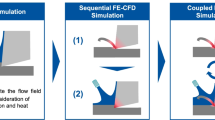Abstract
This study deals with the conjugate heat transfer problem of a single point cutting tool under turning operation dissipating heat in the tool material and streams of the surrounding air. In order to estimate the cutting temperature during the turning operation, the DEFORM-3D finite element package was utilized. A machining simulation material model for Ti6Al4V was utilized using a modified Johnson–Cook equation. The maximum cutting temperature value was obtained from the finite element model. The temperature was then used as a constant heat source on the tool tip, and the conjugate heat transfer (CHT) approach was used to develop a computational fluid dynamics (CFD) model. The CFD model utilized a 3D heat and fluid flow analysis using ANSYS® CFX. A cutting insert with a constant heat source was exposed to the stream velocities of the dry air. The numerical equations governing the flow and thermal fields in the fluid domain and energy equation in the solid domain were solved in parallel by maintaining the continuity of temperature and heat flux at the solid–fluid interface. The presented conjugate heat transfer (CHT) approach provided a very useful understanding of the temperature profile development at the cutting tool that is still a complex challenge for the existing experimental and numerical techniques.
Similar content being viewed by others
References
Shaw, MC (1984) Metal cutting principles. Oxford University Press
Boothroyd G (1989) Fundamentals of machining and machine tools, 2nd ed. Marcel Dekker
Kalpakjian S (1991) Manufacturing processes for engineering materials, 2nd ed. Addison-Wesley
Miller MR, George M, Charles A (2003) Experimental cutting tool temperature distributions. J Manuf Sci Eng 125(4):667–673
Ueda T, Sato M, Nakayama K (1998) The temperature of a single crystal diamond tool in turning. CIRP Ann 47:41–44
Ueda T, Huda MA, Yamada K, Nakayama K (1999) Temperature measurement of CBN tool in turning of high hardness steel. CIRP Ann 48:63–66
Yiğit K, Tuğrul Ö (2005) Predictive analytical and thermal modeling of orthogonal cutting process—part I: predictions of tool forces, stresses, and temperature distributions. J Manuf Sci Eng 128(2):435–444. doi:10.1115/1.2162590
Yiğit K, Tuğrul Ö (2005) Predictive analytical and thermal modeling of orthogonal cutting process—part II: effect of tool flank wear on tool forces, stresses, and temperature distributions. J Manuf Sci Eng 128:445–453. doi:10.1115/1.2162591
Iqbal SA, Mativenga PT, Sheikh MA (2008) An investigative study of the interface heat transfer coefficient for finite element modelling of high-speed machining, proceedings of the institution of mechanical engineers. B J Eng Manuf 222:1405
Samadi F, Kowsary F, Sarchami A (2012) Estimation of heat flux imposed on the rake face of a cutting tool: a nonlinear, complex geometry inverse heat conduction case study. Int Commun Heat Mass Transfer 39(2):298–303
Chen W-C, Tsao C-C, Liang P-W (1997) Determination of temperature distributions on the rake face of cutting tools using a remote method. Int Comm Heat Mass Transfer 24(2):161–170
Rogério Fernandes B, de Carvalho SR, Silva SMMdLe, João Roberto F (2009) Thermal analysis in coated cutting tools. Int Commun Heat and Mass Transfer 36:314–321
Liang L, Hao X, Ke Z (2013) An improved three-dimensional inverse heat conduction procedure to determine the tool-chip interface temperature in dry turning. Int J Therm Sci 64:152–161
Deform-3D (2009) Operational manual, Deform
Özel T, Llanos I, Soriano J, Arrazola PJ (2011) 3D finite modeling of chip formation process for machining Inconel 718: comparison of FE software predictions. Mach Sci Technol 15:21–46
Sima M, Özel T (2010) Modified material constitutive models for serrated chip formation simulations and experimental validation in machining of titanium alloy Ti6Al4V. Int J Mach Tools Manuf 50:943–960
Özel T et al (2010) Investigations on the effects of multi-layered coated inserts in machining Ti6Al4V alloy with experiments and finite element simulations. CIRP Ann Manuf Technol 59:77–82
Karpat Y (2011) Temperature dependent flow softening of titanium alloys Ti6Al4V: an investigation using finite element simulation of machining. J Mater Process Technol 211:737–749
Özel T (2009) Computational modelling of 3D turning with variable edge design tooling: influence of micro-geometry on forces, stresses, friction and tool wear. J Mater Process Technol 209(11):5167–5177
Pervaiz S, Deiab I, Rashid A, Nicolescu CM (2014) Experimental and numerical investigation of TI6AL4V alloy machinability using TiAlN coated tools. NAMRC 42, Detroit, Michigan, USA
Cockroft MG, Latham DJ (1968) Ductility and workability of metals. J Inst Met 96:33–39
Jr Anderson JD, Degroote J, Degrez G, Dick E, Grundmann R, Vierendeels J, Computational fluid dynamics: an introduction, 3rd edition. Springer-Verlag Berlin Heidelberg 1992, 1996, 2009, ISBN: 978-3-540-85055-7
Sayma A (2009) Computational fluid dynamic. Ventus Publishing Aps, ISBN: 978-87-7681-430-4
ANSYS, Inc (2009) ANSYS CFX solver theory guide. USA
Arrazola PJ, Özel T (2010) Investigations on the effects of friction modeling in finite element simulation of machining. Int J Mech Sci 52:31–42
Author information
Authors and Affiliations
Corresponding author
Rights and permissions
About this article
Cite this article
Pervaiz, S., Deiab, I., Wahba, E. et al. A novel numerical modeling approach to determine the temperature distribution in the cutting tool using conjugate heat transfer (CHT) analysis. Int J Adv Manuf Technol 80, 1039–1047 (2015). https://doi.org/10.1007/s00170-015-7086-2
Received:
Accepted:
Published:
Issue Date:
DOI: https://doi.org/10.1007/s00170-015-7086-2



